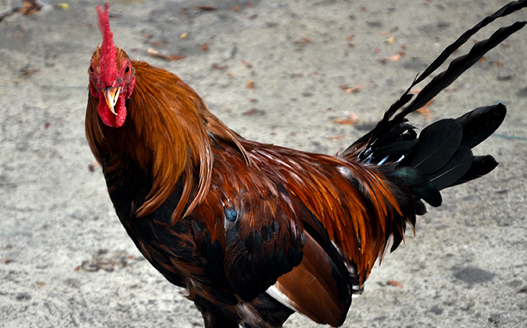
Many may wonder what the big deal is. Why should it matter whether a rooster sounded the alarm or a Temple Crier blew a shofar? In the end, the impact on Peter was the same. He cowered and let his fear get the best of him again. He showed himself that he was not the man of faith he thought he was. So he wept bitterly at the revelation.
There is something so random, arbitrary, and even, to some degree, erratic about the crowing of a rooster. It makes perfect sense to them, though. Their internal body clock will trigger them to caw. If the rooster is high in the social order, he will crow first to assert his territory, protect the females, and avoid fights. To the distress of most humans, they will make themselves heard all day long – whenever they feel threatened, not just to welcome the dawn.
When Jesus told Peter, “Verily I say unto thee, that this night, before the cock crow, thou shalt deny me thrice (Matt 26:34 KJV)” He had a specific time in mind. The “cock crow” He was talking about was not left the whims of a rooster. Nor do I believe God changed the nature of the bird to ensure that it would only crow at a God-ordained moment while every other rooster that might have been outside the walls of Jerusalem was silent.
Yes, I said outside the walls of Jerusalem. Because the Mishna (Baba Kaml, 7,7) stated, “They do not breed cocks at Jerusalem because of the holy things.” The concern was that the chickens might contaminate the sacrifices with the unclean creatures they might drag out of the dung heaps. Keep in mind that not all sacrifices were eaten in the temple. In his book The Temple: Its Ministry and Services as They Were at the Time of Jesus Christ, Bible scholar Alfred Edersheim confirmed that “No even domestic fowls might be kept” in Jerusalem. This, he wrote, was one of the ways the priests “carefully guarded against all possibility of pollution.” Edersheim, a Jewish convert to Christianity, wrote extensively about Jewish traditions and customs during Jesus’ ministry.
I’ve read numerous articles, blog posts, and books on the subject. Some say the Temple Crier was a man given the duel title Gaver (Hebrew), Gawra (Aramaic), meaning man/rooster because his function was similar to a rooster. His job was to awaken the priests and summon them to prepare for the Tamid service. In this case, the Temple Crier climbed to a high point in the Temple and called out, saying, “All priests prepare to sacrifice. All Levites to their stations. All Israelites come to worship.” Some sources say the man was a Roman blowing a trumpet to signal the changing of the guards. Some writers place a horn (shofar) in the hands of a priest who blew it three times to mimic the crowing of a rooster. All agree, however, with the specific time of the call. We find a clue in Mark 13:36, “Watch ye therefore: for ye know not when the master of the house cometh, at even, or at midnight, or at the cockcrowing, or in the morning.” Historically, the Jews had three night watches. But when they came under Roman rule, the three became four.
“Cockcrow” is a term used in Jewish law (kri’at hagever) to identify the third watch, which ends at 3:00 a.m. The Romans referred to it as galliciniuem. The first watch began at sundown and ended at 9:00 p.m.; the second watch began at 9:00 p.m. and ended at midnight; the third watch began at midnight and ended at 3:00 a.m.; and the fourth watch began at 3:00 a.m. and ended at sunrise.
When we take what we know about the night watches and combine that knowledge with the other events that took place before, during, and after Jesus’ crucifixion, it becomes apparent that all of it was symbolically choreographed. His triumphal entry into Jerusalem through the Golden Gate on a donkey in the north section of the east wall of the Temple was in direct contrast to the imperial entry of Pontius Pilate with legions of chariots through the front (west) gate. Jesus championed the kingdom of God, while Pilate represented the power of Rome. The darkness while Jesus was on the cross from noon to 3:00 p.m., the earthquake at 3:00 p.m. at the moment of His death, right when the sacrifice would have taken place in the Temple, and the tearing of the veil, also at the moment of His death.
The cockcrow has greater significance when we place it in the appropriate succession of events because it tells us that at 3:00 a.m., the Lamb of God had been chosen and was on the way to His examination. This correlates to the Temple process of choosing a lamb for the Tamid sacrifice, which began at 3:00 a.m. Once a lamb was chosen, it was examined by the priests to ensure that it was spotless.
It’s interesting to me that even though God is neither bound nor limited by time, He uses it with great precision to emphasize His message. In addition, God uses systems that are already in place for His purposes, especially if they have been established by the enemy. Look, for example, at the Roman method of capital punishment – crucifixion. With that in mind, it is reasonable to conclude that God used the night watches and other temple rituals to emphasize that Jesus was the lamb of God. Not just any lamb, but the Tamid (continuous) offering, which was offered every morning and evening and remained on the altar as a perpetual burnt offering. It seems fitting since our savior’s sacrifice continues to win souls for the kingdom, and Jesus is always at the right hand of God, interceding for us.
There are those who will argue that the cockcrow referred to the call of a rooster because that is the simplest and most popular view. But when we take a more encompassing look at the events, it seems more likely that God would use a man instead of a rooster to signal the selection of His Tamid lamb.



Hi, this is a comment.
To get started with moderating, editing, and deleting comments, please visit the Comments screen in the dashboard.
Commenter avatars come from Gravatar.